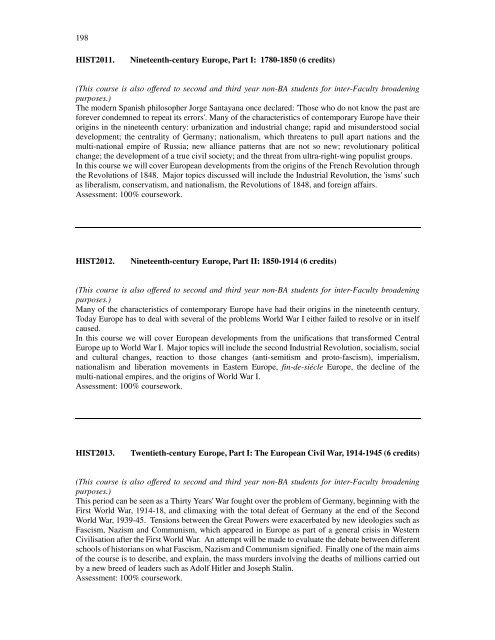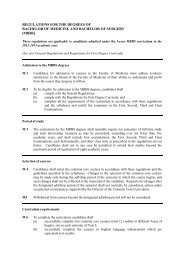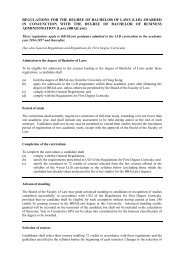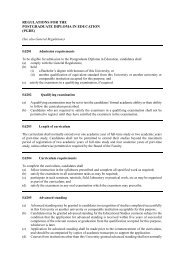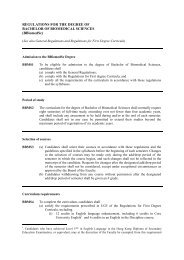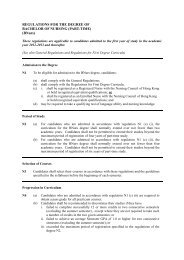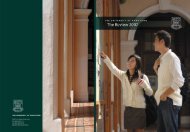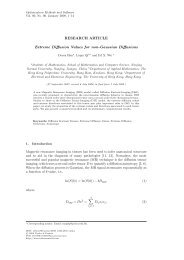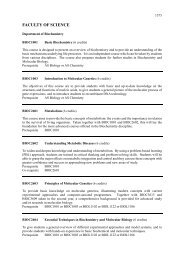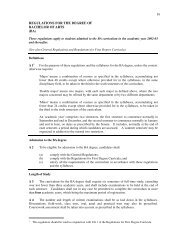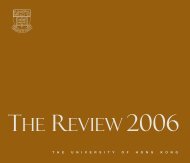Bachelor of Arts (BA) - The University of Hong Kong
Bachelor of Arts (BA) - The University of Hong Kong
Bachelor of Arts (BA) - The University of Hong Kong
You also want an ePaper? Increase the reach of your titles
YUMPU automatically turns print PDFs into web optimized ePapers that Google loves.
198HIST2011.Nineteenth-century Europe, Part I: 1780-1850 (6 credits)(This course is also <strong>of</strong>fered to second and third year non-<strong>BA</strong> students for inter-Faculty broadeningpurposes.)<strong>The</strong> modern Spanish philosopher Jorge Santayana once declared: 'Those who do not know the past areforever condemned to repeat its errors'. Many <strong>of</strong> the characteristics <strong>of</strong> contemporary Europe have theirorigins in the nineteenth century: urbanization and industrial change; rapid and misunderstood socialdevelopment; the centrality <strong>of</strong> Germany; nationalism, which threatens to pull apart nations and themulti-national empire <strong>of</strong> Russia; new alliance patterns that are not so new; revolutionary politicalchange; the development <strong>of</strong> a true civil society; and the threat from ultra-right-wing populist groups.In this course we will cover European developments from the origins <strong>of</strong> the French Revolution throughthe Revolutions <strong>of</strong> 1848. Major topics discussed will include the Industrial Revolution, the 'isms' suchas liberalism, conservatism, and nationalism, the Revolutions <strong>of</strong> 1848, and foreign affairs.Assessment: 100% coursework.HIST2012.Nineteenth-century Europe, Part II: 1850-1914 (6 credits)(This course is also <strong>of</strong>fered to second and third year non-<strong>BA</strong> students for inter-Faculty broadeningpurposes.)Many <strong>of</strong> the characteristics <strong>of</strong> contemporary Europe have had their origins in the nineteenth century.Today Europe has to deal with several <strong>of</strong> the problems World War I either failed to resolve or in itselfcaused.In this course we will cover European developments from the unifications that transformed CentralEurope up to World War I. Major topics will include the second Industrial Revolution, socialism, socialand cultural changes, reaction to those changes (anti-semitism and proto-fascism), imperialism,nationalism and liberation movements in Eastern Europe, fin-de-siécle Europe, the decline <strong>of</strong> themulti-national empires, and the origins <strong>of</strong> World War I.Assessment: 100% coursework.HIST2013.Twentieth-century Europe, Part I: <strong>The</strong> European Civil War, 1914-1945 (6 credits)(This course is also <strong>of</strong>fered to second and third year non-<strong>BA</strong> students for inter-Faculty broadeningpurposes.)This period can be seen as a Thirty Years' War fought over the problem <strong>of</strong> Germany, beginning with theFirst World War, 1914-18, and climaxing with the total defeat <strong>of</strong> Germany at the end <strong>of</strong> the SecondWorld War, 1939-45. Tensions between the Great Powers were exacerbated by new ideologies such asFascism, Nazism and Communism, which appeared in Europe as part <strong>of</strong> a general crisis in WesternCivilisation after the First World War. An attempt will be made to evaluate the debate between differentschools <strong>of</strong> historians on what Fascism, Nazism and Communism signified. Finally one <strong>of</strong> the main aims<strong>of</strong> the course is to describe, and explain, the mass murders involving the deaths <strong>of</strong> millions carried outby a new breed <strong>of</strong> leaders such as Adolf Hitler and Joseph Stalin.Assessment: 100% coursework.


